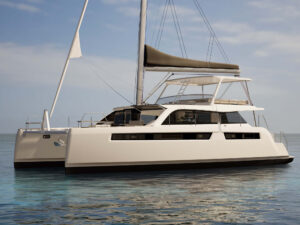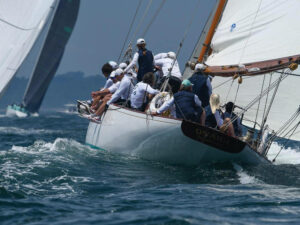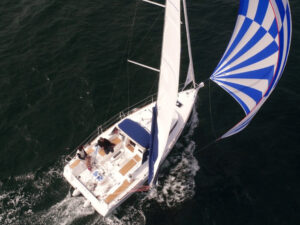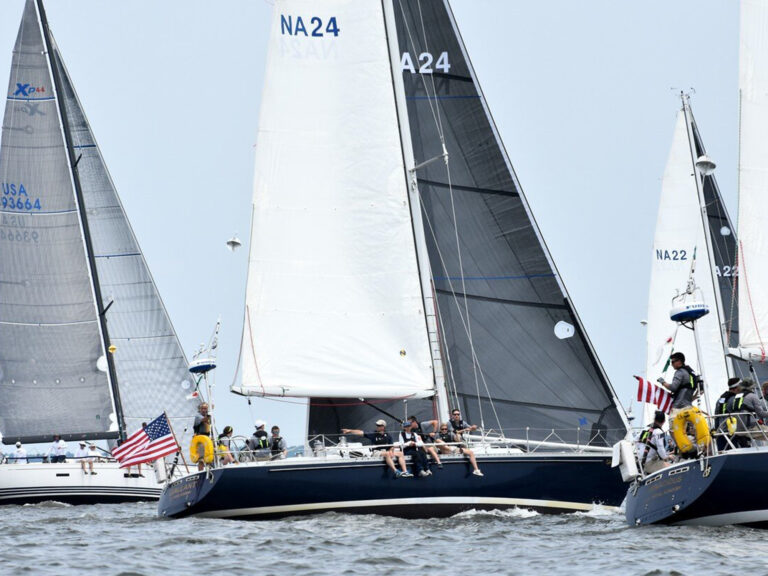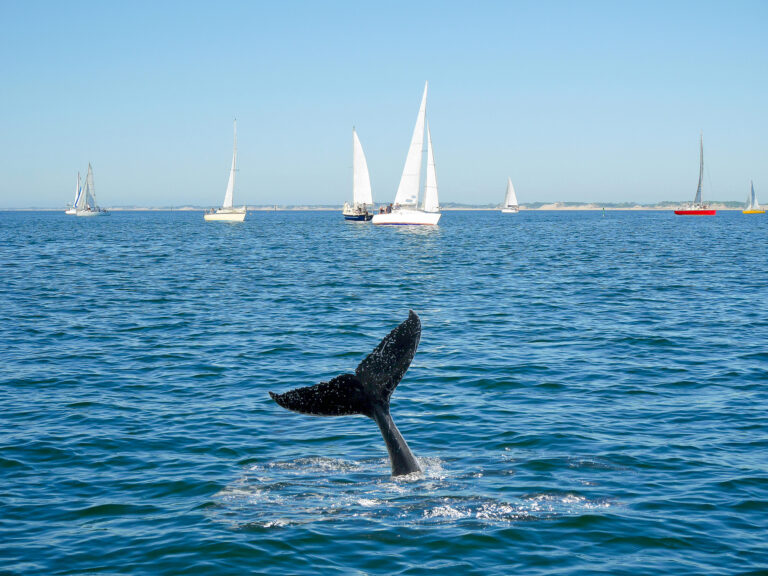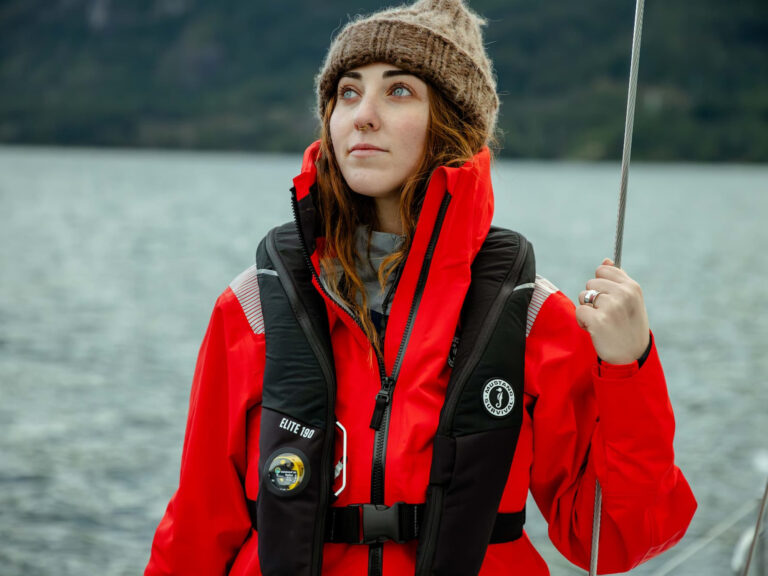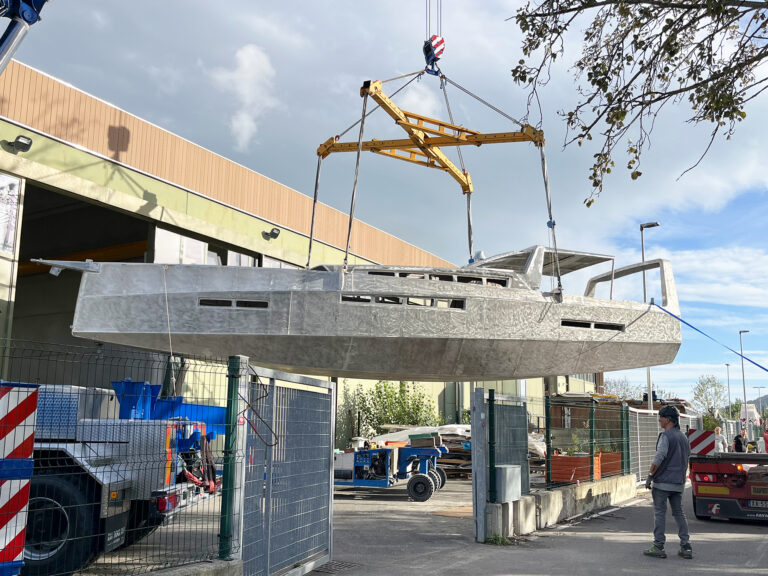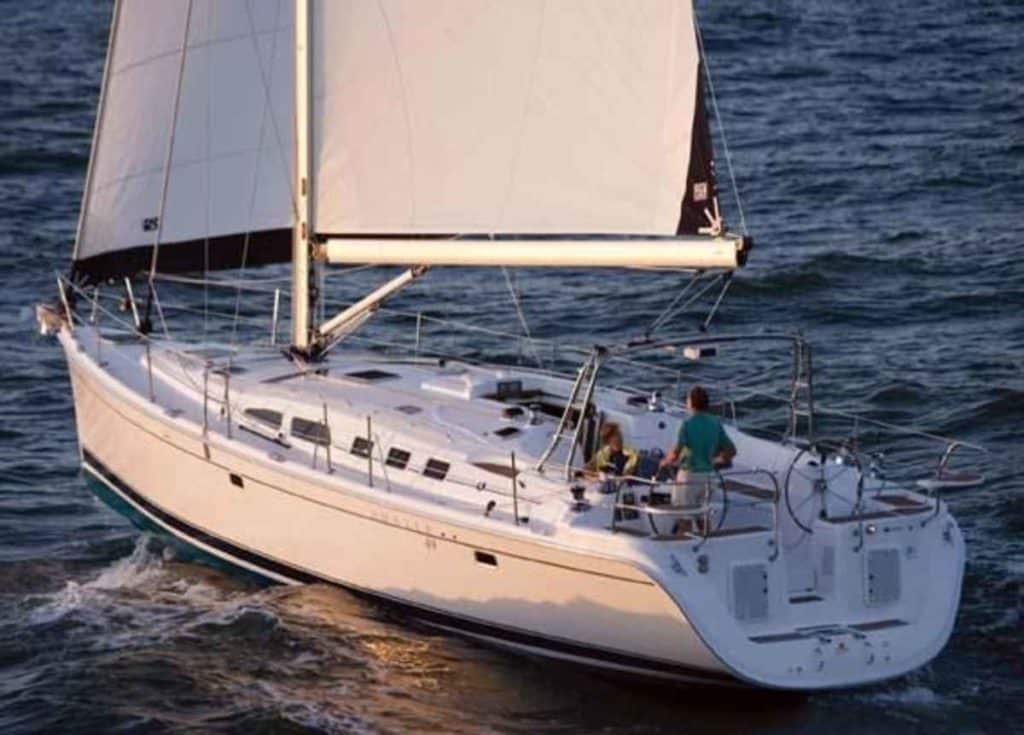
It was on the C&D Canal just past Chesapeake City, Maryland, when it became apparent that this get-acquainted sail on the new Hunter 49 was about to become a road trip. With an early start and fair current up the Chesapeake, motorsailing at 7 to 8 knots had us ahead of schedule, and Steve Pettengill, Hunter Marine’s director of offshore testing, was poking around on the digital charts in hopes of finding a marina for the night. Apparently, though, other seabound traffic headed for Cape May had no need to linger, because there was nary a slip to be found on either shore of Delaware Bay.
And that wasn’t necessarily a bad thing. This new offering by Glenn Henderson and the Hunter design team isn’t your standard-issue floating equivalent of Uncle Fred’s Chevrolet. No, it’s definitely intended for a more discerning traveler-a Buick Roadmaster for the sea, perhaps, and the ride is comfortable.
With my feet up on the Corian-topped table, and shaded by the bimini against the early June sun, I settled in against the cockpit’s high coaming. The low, marshy Delaware countryside crowded the banks to either side. Hull number one is loaded with electronics, solid through the water, and, on this afternoon, promised to be easily handled by a single crew on watch, making an evening on the water something to anticipate, especially since it would likely include sea tales from Pettengill, a singlehanding legend and a clipper-ship-record-bustin’ multihull sailor.
The sailboat was easy enough to spot at the dock at Tidewater Marina, on Back Creek: It’s big for its size. The 49 is actually 49 feet 11 inches LOA, with a 14-foot-5-inch beam and freeboard high enough to make 6-foot-9-inch headroom possible under a low coachroof.
Once aboard, with my travel bag barely tossed below, Pettengill walked the deck describing systems (many), sails (we got the upgraded package on this baby), the anchor locker (to be enlarged a bit on the next hull), the dual bow rollers, the B&R backstay-less rig with double spreaders, the generator (a beefy 12-kilowatt Fisher Panda-got to be able to run everything at once), and, thankfully, breakfast.
Below, we settled in at the wide, solid teak table to enjoy one of several tasty meals supplied by Grog & Gruel Provisioning, in Annapolis, Maryland. Eggs and home fries, like lunch and dinner, were prepared and stored in individually frozen packets, then kept cold in the top-loading freezer located just to starboard and at the foot of the companionway’s wide steps. Dip them into the pan of boiling water on top of the gimbaled, three-burner Seaward Princess stove and oven on the other side of the L-shaped galley, and bon appetit.
Other galley equipment aboard the 49 includes a Kenmore microwave oven with built-in coffeemaker over the stove; forward is a deep double sink and front-loading fridge. The latter had fiddles on the shelves that caused a bit of fumbling during a night watch, but they kept things put while under way. Throughout the galley, Corian countertops with rounded, high fiddles are flanked by ample storage areas and even an attractive, glass-fronted china cabinet.
Forward of the galley, the dining table offers plenty of seating for the crowd you’d be tempted to invite aboard. The outboard settee doubles as an adequate place to nap while under way, and a midships ottoman hides the battery bank (three 8Ds) located under the cabin sole.
Opposite and aft of an ample settee, a forward-facing nav table with captain’s chair offers more than enough space to file away the paper charts you’d seldom need, thanks to the array of Raymarine instruments that can serve up chart, radar, and GPS data in about any combination you’d want. This same information can also appear on the 23-inch flat-panel screen on the saloon bulkhead and on the display screen in the cockpit between the helm stations. The flat panel and another 15-inch screen in the owner’s cabin also tie into the Bose 321 onboard entertainment center.
The 49 comes in a four-cabin charter layout or in one of a pair of three-cabin owner configurations. Hull number one has twin aft cabins. To starboard, there’s a double with a hanging locker, a seat, and a compartment that can be used for pantry or other storage or for a washer and dryer. A second layout option replaces the storage area with room for a workbench or desk. To port, there’s an athwartships double, a large hanging locker, shelving and storage, and an en-suite head and shower that also opens to the main saloon. Between the aft cabins is a kick-out panel that offers an additional means of egress in an emergency. Innerspring mattresses are found on both berths.
Forward, “spacious” comes up short when describing the owner’s cabin on hull number one. An island queen with a memory-foam mattress is flanked by a seat and a cedar-lined hanging locker to port, with a shower compartment just aft. To starboard, there’s a vanity, head, and a second cedar-lined hanging locker. Certainly comfortable at dock or mooring, an owner might, under way, look for a more suitable sea berth farther aft, where the ride would be smoother and there’d be something to lean against while heeled.
Furniture throughout the boat is covered in light-colored, low-maintenance Ultraleather upholstery, which, with the light-colored teak woodwork, makes the interior bright. The cabin sole is low-maintenance as well, made from Everwear gloss teak-and-holly laminate. Pettengill said people buying this boat aren’t looking to spend a lot of time keeping up the woodwork underfoot. But in the same breath, he also took note of the finger holes in many of the floor panels; when lifted, the panels provide access to under-floor tankage, systems, and storage, and Pettengill wondered out loud if there might not be a better design in the offing.
A decade-long veteran with the company and a straight talker, he’s not bashful when it comes to pointing out room for improvement. Additional stainless-steel grabrails will be added to the sides of the companionway, for instance, and the control lever for the electronic gearshift in the cockpit will be shortened or repositioned so it won’t catch on every pocket passing by.
Pettengill’s attention isn’t focused just on cosmetic details, though. He is, after all, the guy the company’s hired to beat and bash early hull numbers so later ones can take a licking. Like most later-day Hunters, the 49, when it was fresh out of the shop, was strapped down and its rigging yanked hard by a crane. For the record, nothing moved, or popped.
And when a suitably windy day presented itself, Pettengill headed out in the 49 and drove it hard up onto the beach on an incoming Florida tide just to see if the keel would budge. It didn’t, and so while pounding into the Delaware Bay in chop kicked up by an opposing 15-knot breeze and current, there wasn’t a squeak or peep below, under power, or later under mainsail and genoa.
Topsides, the all-white hull and deck promises the same low maintenance as the interior. The only material resembling wood to be found is Flexiteek, a PVC-based composite applied to the seats and transom areas. The cockpit is wide and roomy and has an open transom with swim platform, hot and cold shower, a telescoping swim ladder, and panels that swing shut to keep things from being lost off the stern. A pair of Hunter-made davits suspends a dinghy overhead so that even a tall crewmember can pass astern without ducking. Like its predecessors, the 49 sports a stainless-steel arch over the cockpit that puts the mainsheet traveler overhead and out of the way. The arch, Pettengill says with some authority, is tough enough for any crash jibing you’d care to do and does double duty as a bimini frame. A split mainsheet can be trimmed by using either a self-tailing Lewmar 44 winch mounted on the cabin top or a hefty Lewmar 54 self-tailer located at the helm.
The basic 49 comes with a main and a self-tacking 90-percent jib and just the two winches, which, in theory, are adequate, thanks to a brace of line stoppers on either side of the cabin top. Hull number one, however, has been fully tricked out and comes with a beefed-up optional sail package that includes an overlapping 110-percent genoa set on a Harken roller-furler, a staysail, and a full vertical-batten main with Seldén in-mast furling. The Lewmar 44 on the cabin top is augmented with a Lewmar 44 (electric), making halyard work and furling a breeze. At both helm stations, there are Lewmar 54E winches to trim the genoa (and, thanks to a line stopper, the main to starboard) and an additional manual 54 to starboard to handle the spinnaker gear.
A large dodger covers the long companionway entrance, but on this boat it stopped just short of the cockpit seats and did relatively little to block the wind. The bimini that extends forward to meet it made it a tad difficult to step across the wide coamings and onto a side deck that’s only about a foot’s-width wide, part of the compromise involved in pushing the cabin top out to maximize interior volume.
Farther forward, stays and chainplates are located so that you have to squeeze outside or take a step up onto the cabin top when going forward. Below, the uppers are anchored to pads glassed into the hull; lowers connect via tie-rods into the boat’s frame.
The bottom of the hull is solid laminate using epoxy resin in the skim coat for blister protection. The sides are balsa cored, and two layers of a knitted Kevlar fabric run from the keel sump to the stem, where it’s overlapped to create four layers. Hunter uses this technique on all boats over 33 feet for extra puncture resistance. Hull number one has a shoal draft of 5 feet 6 inches and a 12,600-pound keel with wings that reflect Pettengill’s beach-testing program: They’re raised approximately 5 inches so the boat can be heeled and rocked off an obstruction once grounded. A deep-draft model with a 7-foot keel is also available.
A 100-horsepower Yanmar easily pushes the boat at close to 7 knots at 2,500 rpm and half a knot faster at 3,000 rpm. When motorsailing, our pace was a bit better than 8 knots. Engine controls-a Lewmar Mamba gearbox-and-shaft-steering linkage system-are located to port, but a second control can be installed to starboard, too. The 100-amp optional alternator is intended to keep the battery bank topped off so that, in Pettengill’s words, you can always plug in the hair dryer.
In designing the 49, Hunter’s Henderson says the challenge was to create a large, long-distance cruiser with high stability and seakindliness. He wanted it to be easily handled, hence the simple sail plan, keel, and highly balanced rudder, and limited in mast height to accommodate for bridge clearances.
A Performer Under Sail
Late in the evening, and well down Delaware Bay, we finally changed course enough for Pettengill to roll out the sails. Napping below, I hit the deck when I heard the winches start to grind. A stiff boat, the 49 heeled just moderately in 15-plus knots of wind as we scooted north along the New Jersey shore. The high, 4-foot-8-inch freeboard makes boarding from a floating dock a challenge (Pettengill bought a small step stool to keep aboard), but it ensures a dry cockpit, even when the breeze pipes up. Sitting to leeward on a seat designed to let the helmsman lean back against the lifelines and pushpit with feet inboard and a knee on either side of the wheel, I found the boat a pleasure to sail. The helm was balanced, and the boat tracked nicely on a close reach through confused seas with the GPS at 7 knots and better in about 17 knots of true wind.
With a base price of $319,000 (this tricked-out version checked in near $420,000), the Hunter 49 provides a heck of a lot of boat for the buck. As we headed north along the New Jersey shore, with the sun coming up and a gusty breeze pushing us along, about the only thing missing on this road trip was a good Bruce Springsteen CD for a little traveling music.
—
Review #2
Big and beamy, with loads of room below and a huge cockpit for entertaining, the Hunter 49 is the new queen of this company’s fleet. Hull number one came loaded with creature comforts including a freezer and fridge, a washer and dryer, two flat-screen monitors (in the main saloon and the owner’s cabin, forward), a Bose 321 onboard-entertainment center, a full range of electronics, and a Fisher Panda 12-kilowatt generator to power it all. Light-colored woods, upholstery, and ceiling panels and 11 opening ports lend the three-cabin interior a light and airy feel. Of course, all this space comes at a cost: high freeboard and narrow side decks, particularly by the cockpit.
On deck, twin helms allow easy access to the cockpit from the swim platform and open transom. A traveler is mounted overhead on a Hunter stainless-steel arch, with one end of the mainsheet leading down the arch’s side to a portside winch near the helm, while the other end can be trimmed at a winch on the cabin top. The base-model 49 comes with a main, a self-tacking 90-percent jib, and two winches. An upgrade package, which hull number one had, includes a 110-percent genoa, a staysail, a vertical-batten main with Selden in-mast furling, and three additional winches to handle sheets, sail controls, and the spinnaker gear.
Under sail, the 49 curtsied along with modest heel on a near reach at 7 knots in about 17 knots of true wind. Under power, the optional 100-horsepower Yanmar cruised easily at 7-plus knots. A relatively stiff boat, the 49 provides a dry and comfortable ride fit for royalty.
Hunter 49 Specs
LOA: 49′ 11″
LWL: 43′ 10″
Beam: 14′ 5″
Draft (shoal): 5′ 6″
Sail Area: 1,051 sq. ft.
Displacement (shoal): 32,813 lb.
Water: 200 gal.
Fuel: 150 gal.
Engine: 75-hp. Yanmar
Designer: Hunter Design Team
Price: $319,000
Hunter Marine, (386) 462-3077, www.huntermarine.com


